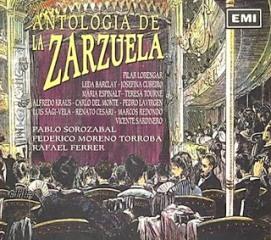Antologia de la Zarzuela (1992)
Antologia de la Zarzuela (1992)

Vol. I 01. La Revoltosa- Preludio 02. La Verbena De La Paloma- Seguidillas 03. La Gran Vía- Chotis De Eliseo Madrileño 04. Agua, Azucarillos Y Aguardiente- Coro De Barquilleros 05. El Ultimo Romantico- Bella Enamorada 06. La Dolores- Jota 07. La Boda De Luis Alfonso- Intermedio 08. Bohemios- Coro De Bohemios 09. El Huesped Del Sevillano- Raquel 10. La Dolorosa- Relato De Rafael 11. La Del Soto Del Parral- Romanza De German 12. Doña Francisquita- Fandango 13. La Alegria De La Huerta- Jota Vol. II 01. La Boda De Luis Alfonso - Intermedio 02. Luisa Fernanda- Mazurca De Las Sombrillas 03. La Tabernera Del Puerto- No Puede Ser 04. La Del Manojo De Rosas- No Corte Mas Que Una Rosa 05. La Del Manojo De Rosas- Hace Tiempo Que Vengo Al Taller 06. La Rosa Del Azafran- Cancion Del Sembrador 07. La Bruja- Jota 08. El Tambor De Granaderos- Jota 09. La Cancion Del Olvido- Cancion De Una Ronda 10. Katiuska- Vivia Sola 11. Molinos De Viento- Serenata 12. La Tabernera Del Puerto- Todos Lo Saben 13. Cádiz – Jota
Zarzuela, form of Spanish or Spanish-derived musical theatre in which the dramatic action is carried through an alternating combination of song and speech. Topics of the libretti (texts of the productions) vary widely, ranging from stories derived from Greco-Roman mythology to tales of modern-day life in Madrid, in former Spanish colonies, or in other areas with a large Hispanic population. Most zarzuelas incorporate vocal ensemble numbers (such as trios and duets), lyrical solo songs known as romanzas, various types of local folk musics, and dance.
The use of music in stage plays had become a standard practice in Spain by the late 15th century, and that practice laid the foundation for the emergence of various forms of Spanish musical theatre. During the early to mid-17th century the arts found favour among the Spanish nobility. King Philip IV (reigned 1621–65) often hosted extravagant receptions that included performances of short comic plays with musical accompaniment. Many of these events were held in La Zarzuela, the royal hunting lodge, so named because it was surrounded by zarzas (“brambles”). Musical theatre performances of the type held at the lodge eventually became known as zarzuelas. Later, during the War of the Spanish Succession (1701–14), such zarzuela performances not only became an official royal spectacle—i.e., a form of entertainment that was sanctioned by the court and intended mainly for the monarchs and the Spanish nobility—but also played an active role in the social and political consolidation of Spain as a monarchy and as a colonial power.
Ultimately, the period of royal sponsorship of zarzuela productions was short-lived, as Italian and French opera became increasingly popular in Spain during the 18th century. Even the Spanish royalty grew to favour foreign opera over local forms of musical theatre. In an attempt to reestablish the integrity of local tradition, King Charles IV decreed at the turn of the 19th century that all foreign operas be performed in Spanish by Spanish citizens. The move did not, however, immediately spark the resurgence of a “national” musical theatre along the lines of the earlier zarzuela-style performances. Rather, the foreign titles continued to be staged, the only significant difference being the language of the texts—now Spanish—and the plots and style of the productions stayed essentially the same. Although it did not entirely yield the intended result, Charles IV’s initiative nevertheless provided Spanish singers with more performance opportunities than they had had in previous decades. Moreover, it laid the foundation for the creation of training schools that would ultimately help to maintain a solid tradition of musical theatre in Spain.
After the Spanish War of Independence, during which musical theatre productions were scarce, Spanish stages continued to be dominated by foreign forms, particularly the French operetta and the Italian bel canto opera, the latter of which was overwhelmingly favoured by King Ferdinand VII. According to Charles IV’s earlier decree, however, the repertoire still had to be performed in Spanish by Spanish citizens. Consequently, a tradition was established whereby audiences were able to experience musical theatre in their native language, which in turn generated a demand for new vernacular musical theatre works, both in Spain and in its colonies.
The first musical theatre piece in Spanish in the 19th century was produced at the Royal Conservatory in Madrid in 1832 and was followed by apparently infrequent performances of other new titles. Opera parodies in Spanish, later known as zarzuelas parodias (“parody zarzuelas”), made a brief appearance during the mid-19th century. Typical zarzuelas parodias mocked Italian operas that had been successful in Spain by appropriating the music but introducing a new plot that ridiculed the original story line. The zarzuelas parodias were important because they created a space for Spanish musical theatre to subvert the dominance of Italian opera on the lyric stages of Spain. --- britannica.com
download: uploaded yandex 4shared mediafire solidfiles mega zalivalka filecloudio anonfiles oboom
Last Updated (Tuesday, 08 July 2014 15:36)








